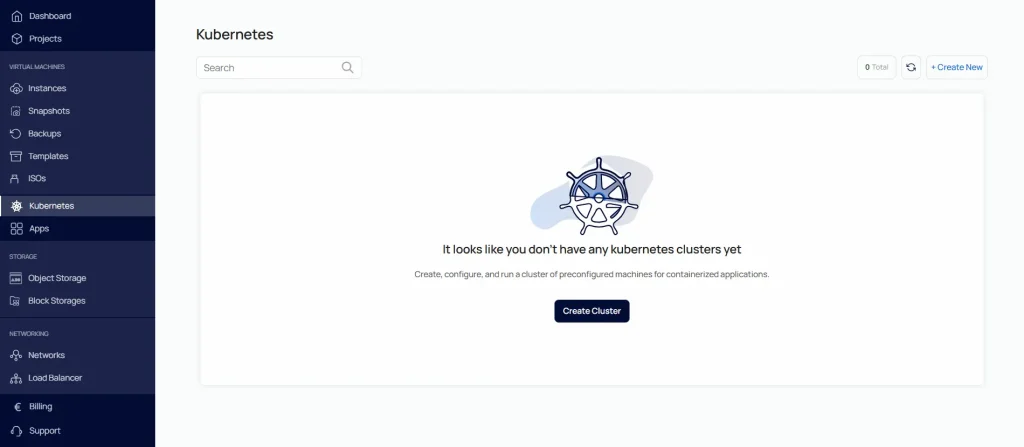If you’re running containerized applications today, chances are you’ve bumped into Kubernetes. It’s become the operating system of modern infrastructure: highly flexible and incredibly powerful, but notoriously complicated when it comes to actual, production-grade hosting.
You can install it manually, automate it with Terraform or go the hyperscaler route and let someone else run it for you… that’s if you’re OK with their pricing model, learning curve and the ecosystem tax that comes with it.
But we think there’s another way.
At LifeinCloud, we’ve built a fully integrated Kubernetes service that gives you a real cluster, with real infrastructure and none of the headache. You get a working Kubernetes environment in a few minutes. No control plane fees. No abstraction layers. And no need to choose between flexibility and simplicity.
This isn’t a hosted marketplace script or a shortcut that breaks when you scale. It’s Kubernetes, as a focus of our platform.

Why we decided to offer Kubernetes as a Service
We didn’t start by asking “how do we add Kubernetes to our platform?”
We asked: “what do our users need if they’re building modern infrastructure?”
And the answer, over and over, was Kubernetes. But not as a template or a one-click install. Developers didn’t want another VPS with Docker pre-installed. They wanted an actual cluster they could use right away: with sane defaults, security in place and support for common patterns like persistent storage, private networking, and automated upgrades.
At the same time, they didn’t want to pay enterprise premiums just to get past the basics.
So we built what we couldn’t find elsewhere:
A real Kubernetes hosting experience that’s simple to deploy, easy to manage and doesn’t box you in. We’ve built our cloud platform on proven open-source technologies: from our orchestration layer to our storage and networking stacks. Not because it’s cost-effective, but because it gives us the flexibility to stay transparent, stay adaptable and avoid locking our users into proprietary traps.
“Our goal wasn’t to compete with the biggest clouds. It was to build the thing we wish we had when we were trying to run Kubernetes ourselves.”
George Lisandru, CTO at LifeinCloud
What you actually get when you launch a cluster
When you deploy Kubernetes on our platform, you’re not installing it manually. You’re provisioning a fully functional, managed cluster with just a few clicks or an API call.
We handle the control plane. You only pay for worker nodes.
You choose:
- The region (London, Frankfurt, Bucharest – Miami is coming soon)
- The Kubernetes version (we support four of the latest)
- Your node configuration and count
- Whether or not to enable high availability (extra control nodes)

Once that’s set, we provision everything automatically: control plane, networking, infrastructure. You receive a ready-to-use kubeconfig file and can immediately begin deploying workloads.
This isn’t a playground cluster… It’s the same stack customers use to run production applications, CI pipelines and customer-facing platforms.
Under the hood: Why it’s fast, stable and predictable
Infrastructure is the difference between a cluster that works and one that causes problems at scale. Everything we’ve built is designed for performance and transparency.
Our cloud runs entirely on NVMe SSDs. That means fast disk I/O by default; not just on paper, but in real-world workloads like databases, CI runners or event queues.
We use software-defined block storage, which gives you durable volumes with triple replication. Every volume you attach is built to survive failure.
Our networking stack includes private networks, virtual private clouds (VPCs), load balancers, and full IPv4/IPv6 support. So when your app grows, your infrastructure doesn’t need to be rebuilt – just extended.
You can also set up fine-grained access controls with built-in IAM and RBAC. Assign users to specific projects. Limit what they can modify. Enforce authentication with two-factor login and audit trails.
This is the kind of control that matters once you move beyond the demo phase. And it’s available from the start, as standard, with no extra fees.
Common use cases we’re seeing (and supporting)
Kubernetes isn’t just for massive teams anymore. The companies using our platform range from solo devs and startups to agencies and internal platform teams.
They’re using it for things like:
- Staging and production environments for SaaS apps
- Isolated client environments in CI/CD pipelines
- API backends with autoscaling and service meshes
- Machine learning pipelines with GPU-enabled node pools
- Self-hosted runners for GitHub Actions and GitLab CI
The common thread is that they all wanted to get to deployment quickly, without spending weeks on setup.
We don’t try to abstract Kubernetes. We just try to remove the work that doesn’t matter.
Cost structure you can actually understand
We don’t charge for the control plane. That’s not a marketing line… it’s just how we’ve built it. You pay for the compute you actually use, on a per-hour basis. No tiered pricing. No surprise bills. No lock-in.
Want to try a staging cluster for a few hours? You can.
Need to scale a production node pool during a traffic spike? Done.
There’s nothing artificial limiting how you grow. And there’s nothing proprietary preventing you from moving your workloads elsewhere later. We think that’s how it should be. Everywhere.
The infrastructure behind it
This matters, especially for teams running real production apps.

Every availability zone (Frankfurt, London, Bucharest) is housed in a Tier III-compliant, GDPR-ready, ISO 27001 certified facility. We run our own hardware and we run it on renewable energy. Everything is redundant: power, cooling, networking. Your workloads aren’t a test case here. They’re first-class citizens.

We also prioritize sustainability. We don’t just host in green facilities: we actively optimize for efficiency, from our cooling design to our energy contracts. It’s better for performance and better for the planet.
What makes us a good Kubernetes cloud provider?
That’s the keyword, right? You might have searched for Kubernetes cloud provider or how to host a Kubernetes cluster and landed here.
So let’s be direct.
We’re not the biggest cloud out there. But that’s exactly why our platform works the way it does:
- No bloated interfaces
- No gatekeeping features behind enterprise contracts
- No AI chatbots between you and actual support
We believe infrastructure should be fast, simple and personal. That’s why we offer:
- Full-featured Kubernetes support
- Straightforward pricing
- Real human support (from certified professionals)
- A developer-first platform that doesn’t waste your time
If that’s the kind of Kubernetes experience you’re looking for, we think you’ll feel right at home here.
Try it, break it, build on it
You can launch your first cluster today. No sales call. No upsell. No nonsense.
If you’re new to Kubernetes, we’ll help you get started. If you’re migrating from another platform, we’ll help you migrate cleanly. If you’re already running something complex and want to simplify it, then we’ll meet you there.
And if you just want to try it and see how it feels? That’s fine too. You’ll know within minutes whether it’s right for you.
Create your first Kubernetes cluster or reach out to our team if you want to talk first.
Either way, we’re here.

